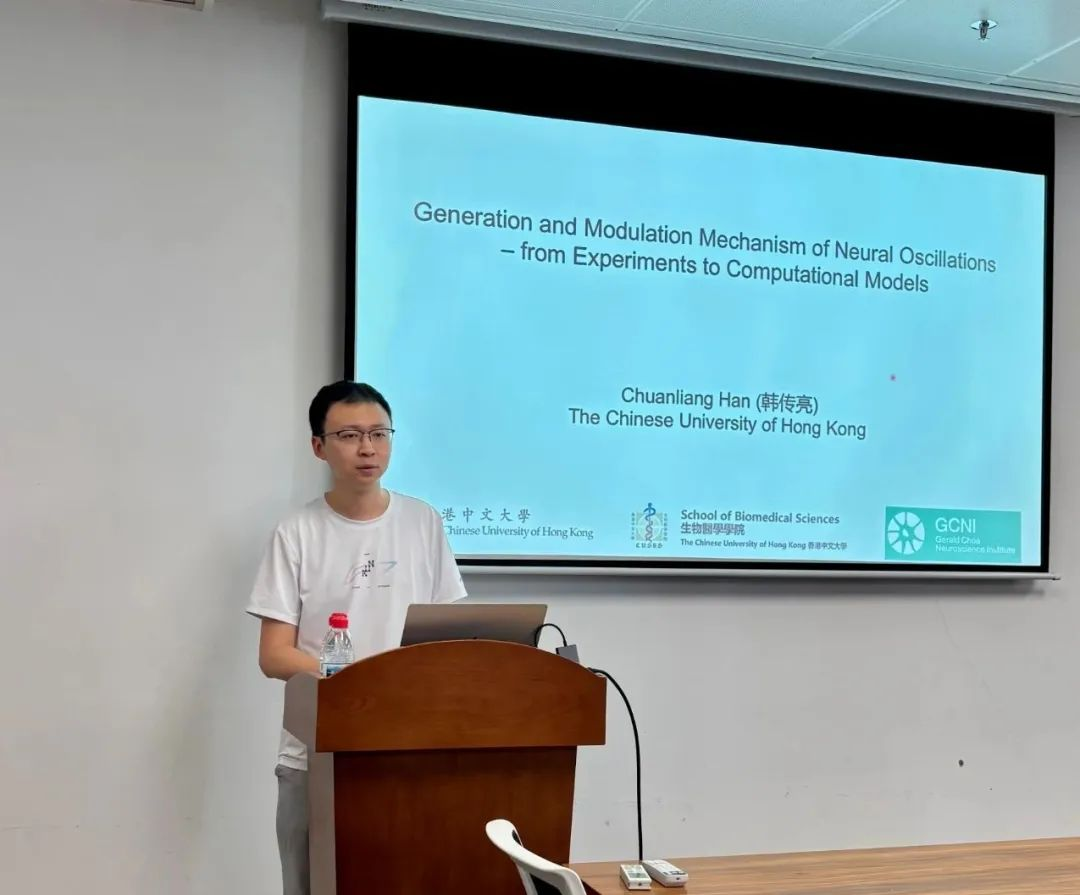On May 15, 2025,Dr. Chuanliang Hanfrom the School of Biomedical Sciences and the Gerald Choa Neuroscience Centre at The Chinese University of Hong Kong delivered an engaging academic lecture titled "Mechanisms of Neural Oscillation Generation and Modulation: From Experiments to Computational Models." The talk centered on the physiological basis and functional mechanisms of neural oscillations, as well as their significance in cognition and neurological disorders. Through a combination of multi-scale experimental data and computational modeling, Dr. Han illuminated the complex properties of gamma and alpha oscillations and their potential clinical applications.

1. Classification and Functional Framework of Neural Oscillations
Dr. Han began by emphasizing that neural oscillations are a key feature of the brain’s complex networks. The spectral profile of neural activity can be divided into periodic and aperiodic components. Periodic neural activity, characterized by narrow-band oscillations, is closely linked to neural information encoding and integration. In contrast, aperiodic activity manifests as random fluctuations, potentially reflecting the overall excitability state of neuronal populations.
2. Multiple Origins of Gamma Oscillations and Mechanisms of Visual Encoding
The origins of gamma oscillations have long been debated—particularly in the visual system, where it remains unclear whether they arise from cortical or subcortical structures. Dr. Han addressed this controversy through experiments involving different spatial frequencies (SF). His findings revealed that gamma oscillations can be further divided into three sub-bands: low (25–40 Hz), medium (45–60 Hz), and high (65–90 Hz), each responsible for encoding different spatial frequency ranges and associated with distinct neural circuits. This discovery reconciles previous inconsistencies by suggesting that the heterogeneity of gamma activity stems from dynamic switching between neural circuits under different task demands.
3. Lifespan Regulation and Pathological Associations of Alpha Oscillations
Alpha rhythms are hallmark features of the brain’s resting state and are primarily generated through interactions within thalamo-cortical circuits. Dr. Han highlighted previous findings suggesting the presence of distinct“pacemakers”for different alpha rhythms. He emphasized that inhibitory interneurons in the cortex, such as SST+ (somatostatin-expressing) cells, also contribute to maintaining the stability of alpha oscillations by regulating excitation-inhibition (E–I) balance across brain regions.
Through longitudinal tracking, Dr. Han’s team discovered a nonlinear trajectory in alpha power and frequency across the lifespan:
Young adulthood (<30 years): Alpha power gradually increases alongside cognitive development, with frequency stabilizing at 10–12 Hz;
Middle age (30–55 years): Both power and peak frequency reach their highest levels;
Older age (>55 years): Alpha power declines significantly, showing strong associations with cognitive decline, including in neurodegenerative conditions such as Alzheimer’s disease (AD).
4. Regulation of Neural Oscillations and Prospects for Application
To explore the modulation of neural oscillations, Dr. Han’s team proposed several innovative intervention strategies:
Physical exercise as a non-invasive neuromodulation approach:
Through an 8-week intervention study comparing high-intensity interval training (HIIT) and yoga, the researchers found that HIIT significantly increased mid-alpha power, which was associated with reductions in body fat. In contrast, yoga improved sleep quality by enhancing alpha activity.
Clinical potential of portable EEG technology:
By continuously tracking alpha wave dynamics in individual participants, the team demonstrated the feasibility of constructing personalized "neural oscillation fingerprints." This approach may offer objective biomarkers for the early diagnosis and treatment monitoring of psychiatric disorders.
5. Conclusion and Future Outlook
In his closing remarks, Dr. Han emphasized that research on neural oscillations is progressing from phenomenological descriptions to mechanistic understanding and clinical translation. On the theoretical front, he called for the development of multi-scale models that integrate molecular, cellular, and circuit-level mechanisms to uncover the biological basis of oscillatory heterogeneity. On the applied side, he highlighted the need to develop oscillation-based biomarkers and to combine physical interventions with neuromodulation techniques—such as closed-loop deep brain stimulation—to advance precision neuropsychiatric medicine.